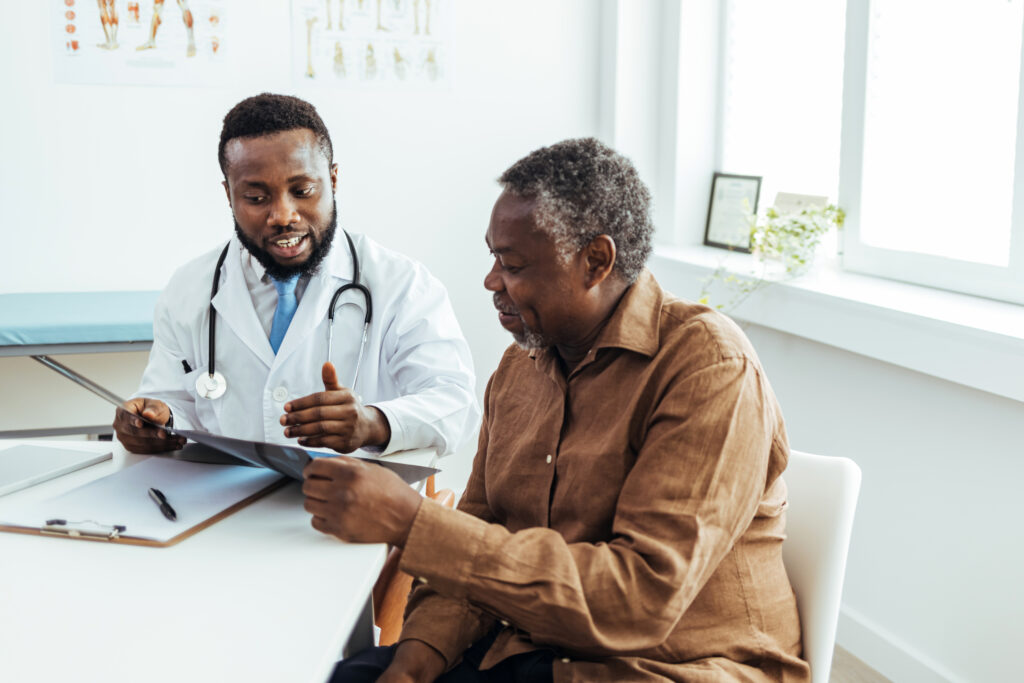According to a 2022 study funded by the Heart & Stroke Foundation, strokes are on the rise in Canada. The risk of stroke rises rapidly after age 55[1].
Strokes are caused when there is a blockage to part of the brain or when a blood vessel in the brain bursts. In either case, parts of the brain become damaged or die. Eighty percent of those who have a stroke survive[2].
WHAT IS POST-STROKE SPASTICITY (PSS)?
For up to 43% of survivors,[3] [4] a stroke can damage a part of the brain that controls certain muscles in the body. Post-stroke spasticity (PSS) is a condition in which there is an abnormal increase in muscle tone or stiffness. Muscles become overactive, causing them to contract and it can be associated with discomfort or pain.
HOW DO YOU DIAGNOSE PSS?
Post-stroke spasticity does not always appear immediately after a stroke. It’s important to talk to your doctor if you think you or your loved one who experienced a stroke may have signs and symptoms of spasticity. Early intervention is important as the condition can worsen over time[5].
PSS may present with a variety of signs and symptoms[6] [7] [8]
– Feeling that you have no control over your muscles
– Stiffness in the arms, legs, hands or feet
– Uncontrollable moving or jerking
– Increased muscle tone or resistance
– Abnormal postures
– Reflexes that are over-responsive
HOW DOES PSS IMPACT LIVES?
PSS can affect balance, coordination and movement[9]. It impacts day-to-day living, making simple tasks like getting dressed, bathing, moving around or eating challenging. It can cause pain and pressure sores and could be associated with falls and fractures. For all these reasons, while PSS is physical, it can also lead to emotional impacts such as decreased quality of life, social isolation and higher rates of depression after a stroke[10].
HOW IS PSS MANAGED?
Thankfully, once PSS is diagnosed, there are many ways to help relieve symptoms, improve the ability to do daily activities, and maintain or improve movement.
A health professional such as a stroke rehabilitation specialist can identify what might be best for you through some of the following recommendations:
– Physiotherapy and occupational therapy which can help with:
- increasing strength and coordination;
- maintaining or improving movement;
- improving comfort;
- braces, splints or casts;
- home modifications.
– Medication
- A number of different medications treat of the symptoms of spasticity
– Surgery
- In some cases, surgery may be helpful.
After acting FAST to the signs and symptoms of a stroke, it’s important to REACT to post-stroke spasticity, to ensure an early diagnosis and receive treatment promptly. REACT stands for:
Restricted movement
Decreased movement may indicate PSS. This can occur in the upper and/or lower body, so it is important to test your range of motion of your arms and legs[11].
Early detection & intervention is best
Ensure your condition is monitored early and periodically after you are discharged. If you notice increased muscle stiffness, tightness or dexterity problems, contact your doctor. Early detection and intervention may help to prevent complications and improve mobility and rehabilitation[12] [13].
Altered Function
PSS can affect the ability to perform day-to-day activities and this can have an impact on your social interactions and emotional well-being[14]. Contact your doctor if you are experiencing pain, muscle stiffness, excessive muscle spasms, and/or lack of muscle control.
Change in muscle stiffness or posture
Muscle stiffness can start gradually and subtly increase over time[15]. Muscles may resist being stretched and tight muscles may impede your ability to perform activities independently. Incorrect movement patterns and incorrect posture may also occur and can have a long-term impact.
Talk to your doctor
Increasing spasticity following a stroke can result in long-term disability[16]. Talk to your doctor or rehab specialist about your symptoms to ensure an early diagnosis and appropriate treatment.
Find out more about post-stroke spasticity and how it can be managed by speaking with a physician.
Brought to you by AbbVie Canada.
[1] Government of Canada. Stroke in Canada. Retrieved from https://www.canada.ca/en/public-health/services/publications/diseases-conditions/stroke-in-canada.html.
[2] Heart and Stroke Foundation of Canada. (2017). 2017 Stroke Report. Retrieved from https://www.heartandstroke.ca/-/media/pdf-files/canada/stroke-report/strokereport2017en.ashx.
[3] Wissel, J, Songjin, R. (2021). Assessment, goal setting, and botulinum neurotoxin a therapy in the management of post-stroke spastic movement disorder: Updated perspectives on best practice. Expert Review of Neurotherapeutics. https://doi.org/10.1080/14737175.2021.2021072
[4] Gillard PJ et al. (2015). The negative impact of spasticity on the health-related quality of life of stroke survivors: A longitudinal cohort study. Health and Quality of Life Outcomes, 13(159). https://doi.org/10.1186/s12955-015-0340-3
[5] Wissel J, Schelosky LD, Scott J, et al. Early development of spasticity following stroke: a prospective, observational trial. J Neurol 2010;257:1067-1072.
[6] https://www.stroke.org/en/about-stroke/effects-of-stroke/physical-effects-of-stroke/physical-impact/spasticity
[7] https://www.ninds.nih.gov/health-information/disorders/spasticity
[8] https://www.aans.org/Patients/Neurosurgical-Conditions-and-Treatments/Spasticity
[9] https://www.stroke.org/en/about-stroke/effects-of-stroke/physical-effects-of-stroke/physical-impact/restoring-your-balance
[10] https://www.strokebestpractices.ca/recommendations/mood-cognition-and-fatigue-following-stroke/post-stroke-depression
[11] Bethoux, F. (2015). Spasticity Management After Stroke. DOI: 10.1016/j.pmr.2015.07.003
[12] Christofi. G. (2018). Improving the Management of Post-Stroke Spasticity: Time for Action. DOI: 10.2340/20030711-1000004.
[13] Glaess-Leistner. S. et al. (2021). Early clinical predictors of post stroke spasticity. DOI: 10.1080/10749357.2020.1843845.
[14] Christofi. G. (2018). Improving the Management of Post-Stroke Spasticity: Time for Action. DOI: 10.2340/20030711-1000004.
[15] Wissel, J., et al. (2020). Development of an Early Identification Tool in Post-Stroke Spasticity (PSS): The PSS Risk Classification System. https://doi.org/10.1016/j.apmr.2020.09.101
[16] Thibaut, A., et al. (2013). Spasticity after stroke: physiology, assessment and treatment. DOI: 10.3109/02699052.2013.804202.
CA-BNO-230034

